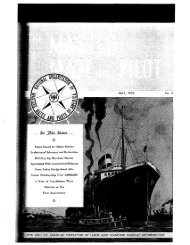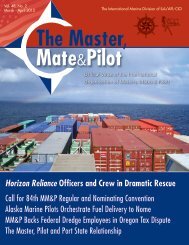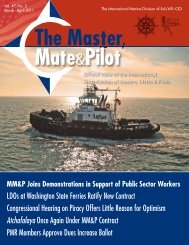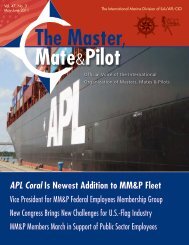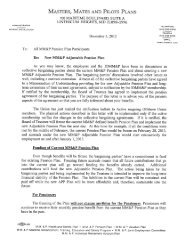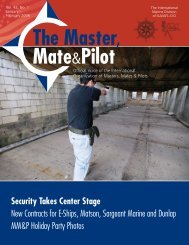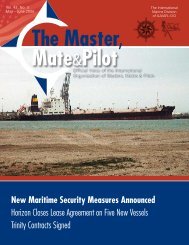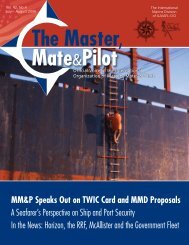Teamwork and Solidarity at 81st Convention In the News: Maunalei ...
Teamwork and Solidarity at 81st Convention In the News: Maunalei ...
Teamwork and Solidarity at 81st Convention In the News: Maunalei ...
- No tags were found...
You also want an ePaper? Increase the reach of your titles
YUMPU automatically turns print PDFs into web optimized ePapers that Google loves.
NEWS Briefs (CONTINUED)<strong>In</strong> launching <strong>the</strong> initi<strong>at</strong>ive, Seafarers’ Section AssistantSecretary John Bainbridge said <strong>the</strong> ITF was disappointedwith <strong>the</strong> way th<strong>at</strong> existing regul<strong>at</strong>ions were being enforced,especially in light of <strong>the</strong> fact th<strong>at</strong> more countries nowrecognize th<strong>at</strong> f<strong>at</strong>igue is a significant factor in manymaritime accidents. The problem was highlighted by aMarine Accident <strong>In</strong>vestig<strong>at</strong>ion Board (MAIB) study in<strong>the</strong> United Kingdom th<strong>at</strong> pointed to flag-of-convenience(FOC) st<strong>at</strong>es’ authoriz<strong>at</strong>ion of low manning levels forcompetitive advantage as a major cause of accidents. Themost obvious examples of unrealistic manning leading tof<strong>at</strong>igue-rel<strong>at</strong>ed accidents are ships with a two-w<strong>at</strong>ch systemor a single w<strong>at</strong>chst<strong>and</strong>er on <strong>the</strong> bridge, Bainbridge said.Many companies are well aware of <strong>the</strong> problems causedby increased workloads for seafarers, he added. But far toomany flag st<strong>at</strong>es <strong>and</strong> shipping companies have ignored<strong>the</strong>se neg<strong>at</strong>ive pressures on <strong>the</strong> seafarer <strong>and</strong> determinemanning levels based solely on competitive consider<strong>at</strong>ions.Bainbridge asks affili<strong>at</strong>ed unions to send <strong>the</strong> ITF details ofaccidents or injuries to seafarers in which f<strong>at</strong>igue is a factor.NS Savannah Again UnderwayOn August 15, 35 years after being taken out of service,NS Savannah once again had w<strong>at</strong>er moving under her keel.The 20-mile voyage under tow was <strong>the</strong> first step in a plan toget <strong>the</strong> 596 foot, 22,000 ton displacement ship “spruced up”after seven years in <strong>the</strong> Maritime Administr<strong>at</strong>ion’s JamesRiver “<strong>In</strong>active Fleet” facility off Fort Eustis, Va. Tugs movedSavannah, a registered N<strong>at</strong>ional Historic L<strong>and</strong>mark, toColonna Shipyard on <strong>the</strong> Elizabeth River in Norfolk. ThereNS Savannah, a registered N<strong>at</strong>ional HistoricL<strong>and</strong>mark, is again underway.she will undergo a cleanup <strong>and</strong> repair on her topside decks<strong>and</strong> interior spaces before being moved to ano<strong>the</strong>r yardfor <strong>the</strong> removal of her nuclear power plant. The fuel wasremoved when Savannah was inactiv<strong>at</strong>ed.Designed by George Sharp <strong>In</strong>c. <strong>and</strong> built in Camden,N.J., by <strong>the</strong> New York Shipbuilding Corpor<strong>at</strong>ion, Savannahwas christened in 1959 <strong>and</strong> delivered to <strong>the</strong> MaritimeAdministr<strong>at</strong>ion in 1962. Constructed under PresidentEisenhower’s “Atoms for Peace” program as a demonstr<strong>at</strong>ionof <strong>the</strong> peacetime applic<strong>at</strong>ion of <strong>at</strong>omic energy, her sleeklines <strong>and</strong> gleaming white hull made her easily recognizable.Originally oper<strong>at</strong>ed by St<strong>at</strong>es Marine Lines <strong>and</strong> <strong>the</strong>n byAmerican Export Isbr<strong>and</strong>tsen Lines, <strong>the</strong> combin<strong>at</strong>ionpassenger/cargo ship traveled more than 450,000 milesduring her short nine years <strong>at</strong> sea. To go th<strong>at</strong> distance, her20,000 shaft horsepower Babcock & Wilcox nuclear powerplant used just 163 pounds of uranium fuel. With a full crewof 110, Savannah could carry 60 passengers in 30 cabins, aswell as 10,000 tons of cargo in her six holds.Although <strong>the</strong> project was deemed a huge success inmany areas, her $2,000,000 per year oper<strong>at</strong>ing subsidy madeher an easy target for cutbacks in government spending <strong>and</strong>she was taken out of service in 1971. After spending 13 yearsas a w<strong>at</strong>erfront exhibition in Charleston, S.C., Savannah wastowed to Baltimore, preserved for storage, <strong>and</strong> moved to <strong>the</strong>James River facility in 1999.— Photo <strong>and</strong> text by Dave BerquistCourt Rules AgainstDepartment of Homel<strong>and</strong>Security in PersonnelSystem OverhaulAn appeals court has ruled against <strong>the</strong> Department ofHomel<strong>and</strong> Security (DHS) in a case th<strong>at</strong> involves yet ano<strong>the</strong>r<strong>at</strong>tempt by <strong>the</strong> federal government to curb <strong>the</strong> collectivebargaining rights of its employees. The unanimous decision,by <strong>the</strong> U.S. Court of Appeals for <strong>the</strong> District of Columbia,upheld <strong>and</strong> broadened a lower court’s decision to strikedown significant portions of DHS’s new labor rel<strong>at</strong>ionssystem. <strong>In</strong> confirming <strong>the</strong> decision of <strong>the</strong> lower court, <strong>the</strong>three-judge panel ruled th<strong>at</strong> <strong>the</strong> system as proposed byDHS would illegally curtail collective bargaining rightsfor employees by giving management <strong>the</strong> ability to cancel- 12 - September – October 2006 The Master, M<strong>at</strong>e & Pilot



